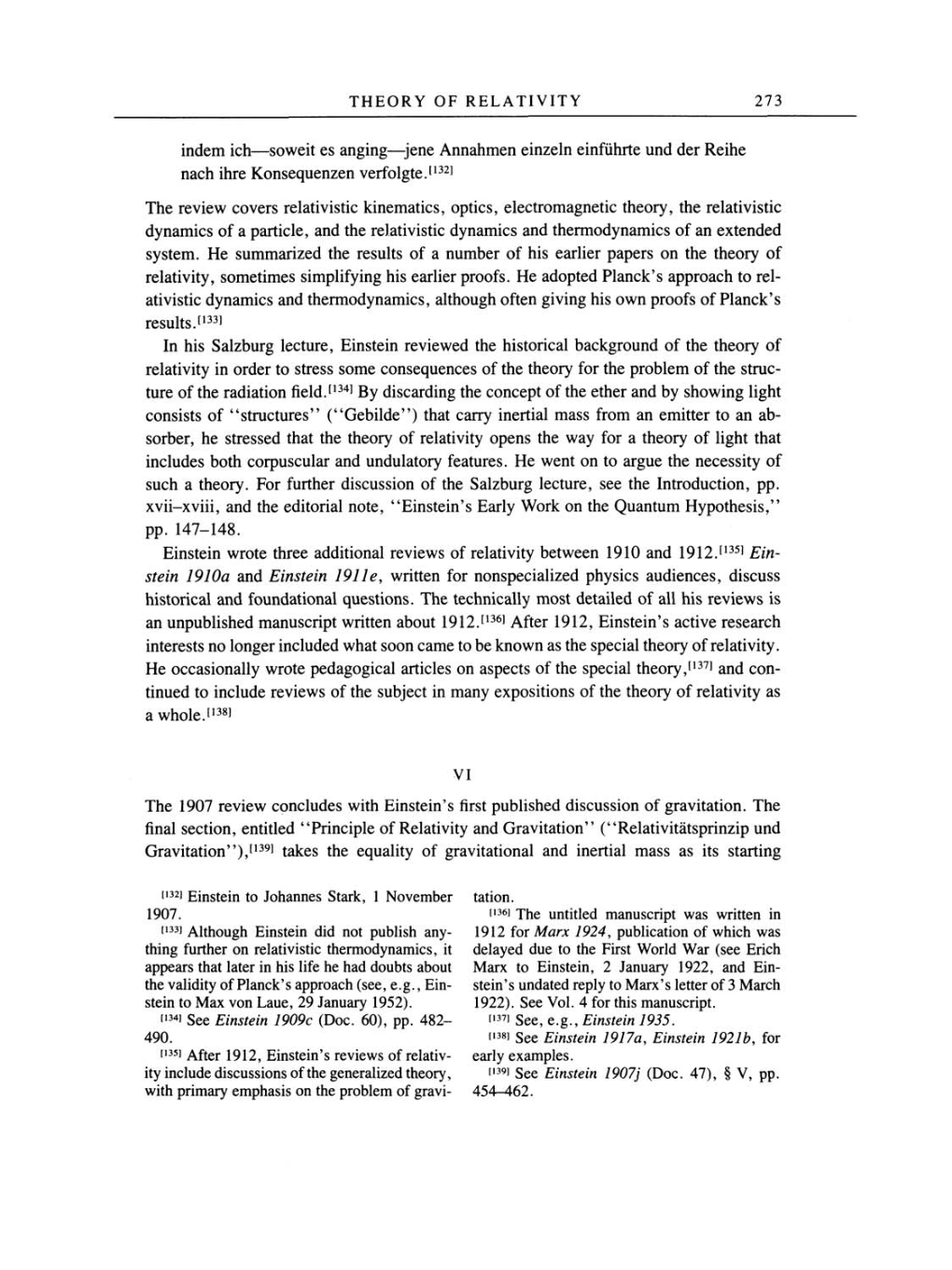THEORY OF RELATIVITY 273
indem
ich-soweit
es
anging-jene Annahmen einzeln einführte und
der
Reihe
nach ihre
Konsequenzen
verfolgte.[132]
The review
covers
relativistic
kinematics,
optics,
electromagnetic
theory,
the
relativistic
dynamics
of
a particle,
and the relativistic
dynamics
and
thermodynamics
of
an
extended
system.
He summarized the results
of
a
number
of his earlier
papers
on
the
theory
of
relativity,
sometimes
simplifying
his earlier
proofs.
He
adopted
Planck's
approach
to rel-
ativistic
dynamics
and
thermodynamics, although
often
giving
his
own proofs
of Planck's
results.[133]
In his
Salzburg
lecture,
Einstein reviewed the historical
background
of
the
theory
of
relativity
in
order to stress
some consequences
of
the
theory
for the
problem
of
the struc-
ture
of
the radiation
field.[134]
By discarding
the
concept
of
the ether and
by showing light
consists
of "structures"
("Gebilde")
that
carry
inertial
mass
from
an
emitter to
an
ab-
sorber,
he stressed
that the
theory
of
relativity opens
the
way
for
a
theory
of
light
that
includes both
corpuscular
and
undulatory
features. He went
on
to
argue
the
necessity
of
such
a
theory.
For further discussion
of
the
Salzburg
lecture,
see
the
Introduction,
pp.
xvii-xviii, and the editorial
note,
"Einstein's
Early
Work
on
the
Quantum Hypothesis,"
pp.
147-148.
Einstein wrote three
additional reviews
of
relativity
between 1910 and
1912.[135]
Ein-
stein 1910a and Einstein
1911e, written for
nonspecialized physics
audiences,
discuss
historical and foundational
questions.
The
technically
most detailed
of
all his
reviews
is
an unpublished manuscript
written about
1912.[136]
After
1912,
Einstein's
active
research
interests
no longer
included what
soon came
to be known
as
the
special theory
of
relativity.
He
occasionally
wrote
pedagogical
articles
on aspects
of
the
special
theory,[137]
and
con-
tinued to include reviews
of
the
subject
in
many expositions
of
the
theory
of
relativity as
a
whole.[138]
VI
The 1907 review concludes with
Einstein's
first
published
discussion
of
gravitation.
The
final
section,
entitled "Principle
of
Relativity
and
Gravitation"
("Relativitätsprinzip
und
Gravitation"),[139]
takes the
equality
of
gravitational
and inertial
mass as
its
starting
[132]
Einstein to Johannes
Stark,
1
November
1907.
[133]
Although
Einstein did
not
publish any-
thing
further
on
relativistic
thermodynamics,
it
appears
that later in his life he had doubts about
the
validity
of Planck's
approach
(see, e.g.,
Ein-
stein
to
Max
von
Laue,
29
January
1952).
[134]
See
Einstein
1909c
(Doc. 60),
pp.
482-
490.
[135]
After
1912,
Einstein's
reviews
of
relativ-
ity
include discussions
of
the generalized
theory,
with
primary emphasis on
the
problem
of
gravi-
tation.
[136]
The untitled
manuscript was
written in
1912
for Marx
1924,
publication
of
which
was
delayed
due
to the First World War
(see
Erich
Marx
to Einstein, 2
January
1922,
and Ein-
stein's
undated
reply
to
Marx's
letter
of
3
March
1922).
See Vol. 4 for this
manuscript.
[137] See,
e.g., Einstein 1935.
[138]
See
Einstein
1917a,
Einstein
1921b,
for
early examples.
[139]
See Einstein
1907j
(Doc.
47),
§
V,
pp.
454-462.
